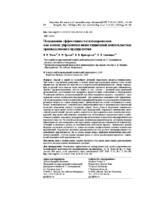| dc.contributor.author | Чазов, Е. Л. | |
| dc.contributor.author | Грахов, В. П. | |
| dc.contributor.author | Криворотов, В. В. | |
| dc.contributor.author | Симченко, О. Л. | |
| dc.coverage.spatial | Минск | ru |
| dc.date.accessioned | 2019-02-04T07:22:05Z | |
| dc.date.available | 2019-02-04T07:22:05Z | |
| dc.date.issued | 2019 | |
| dc.identifier.citation | Повышение эффективности планирования как основа управления инвестиционной деятельностью промышленного предприятия = Improving the Efficiency of Planning as a Basis for Management the Investment Activity of an Industrial Enterprise / Е. Л. Чазов [и др.] // Энергетика. Известия высших учебных заведений и энергетических объединений СНГ. – 2019. – № 1. – С. 88-100. | ru |
| dc.identifier.uri | https://rep.bntu.by/handle/data/49410 | |
| dc.description.abstract | Первой и одной из важнейших функций управления является планирование. При этом в современных рыночных условиях время для реализации данного этапа весьма ограничено. Во многом это относится и к нефтегазовой промышленности. Ввиду сокращения ресурсной базы отрасли доля сверхприбыльных проектов значительно уменьшилась. Добыча трудноизвлекаемых запасов нефти и газа связана с активной инвестиционной деятельностью, необходимостью внедрения дорогостоящих технологий и оборудования. Рассмотрим наиболее распространенный вид инвестиционного проекта, связанного с проведением геолого-технических мероприятий. Для повышения экономической эффективности от проведения геолого-технических мероприятий предлагается реализовать автоматизированную модель на стадии планирования. Данная модель на основе обобщенных геологических, технологических, статистических, макроэкономических и экономических показателей позволяет оперативно решить следующие задачи: более точно и оперативно планировать затраты на проведение геолого-технических мероприятий; определить минимально допустимый рентабельный уровень дебита нефти после проведения геолого-технических мероприятий; определить максимально экономически обоснованную продолжительность капитального ремонта скважины; упорядочить проекты геолого-технических мероприятий по их привлекательности. По итогам реализации автоматизированной модели составлена матрица эффективности для конкретного месторождения, определяющая влияния необходимых инвестиций и планового дебита на экономические показатели проекта. Применение данной матрицы позволило исключить из плана несколько неэффективных геолого-технических мероприятий. Разработана методика ранжирования на базе расчета интегрированного коэффициента эффективности. На ее основе решен вопрос принятия оптимальных управленческих решений с учетом оценки влияния риска в случае рассмотрения проектов с одинаковой экономической эффективностью. | ru |
| dc.language.iso | ru | ru |
| dc.publisher | БНТУ | ru |
| dc.title | Повышение эффективности планирования как основа управления инвестиционной деятельностью промышленного предприятия | ru |
| dc.title.alternative | Improving the Efficiency of Planning as a Basis for Management the Investment Activity of an Industrial Enterprise | ru |
| dc.type | Article | ru |
| dc.identifier.doi | 10.21122/1029-7448-2019-62-1-88-100 | |
| local.description.annotation | The first and one of the most important functions of management is planning. At the same time, in the current market conditions, the time for the implementation of this stage is very limited. In many ways, this applies to the oil and gas industry all the same. Due to the reduction of the resource base of the industry, the share of super-profitable projects has decreased significantly. Extraction of hard-to-recover oil and gas reserves is associated with active investment activities and with the need to introduce expensive technologies and equipment. The most common type of investment project associated with the geological and technical activities is being considered in the present paper. In order to increase the economic efficiency of the geological and technical activities it is proposed to implement an automated model at the stage of planning. This model, on the basis of the generalized geological, technological, statistical, macroeconomic and economic indicators, allows to solve quickly the following problems: of more precise and prompt planning the expenses on carrying out geological and technical actions; of defining minimum admissible profitable level of an oil flow rate after carrying out geological and technical actions; of determining the most economically justified duration of the overhaul of the well; of organizing the projects of geological and technical measures according to their attractiveness. As a result of the implementation of the automated model, an efficiency matrix for a particular field was compiled that determines the impact of the necessary investments and planned flow rate on the economic indicators of the project. The use of this matrix made it possible to exclude several inefficient geological and technical measures from the plan. The method of ranking based on the calculation of the integrated efficiency coefficient has been developed. On its basis, the issue of making optimal management decisions taking into account the impact of risk assessment in the case of projects with the same economic efficiency is solved. | ru |

